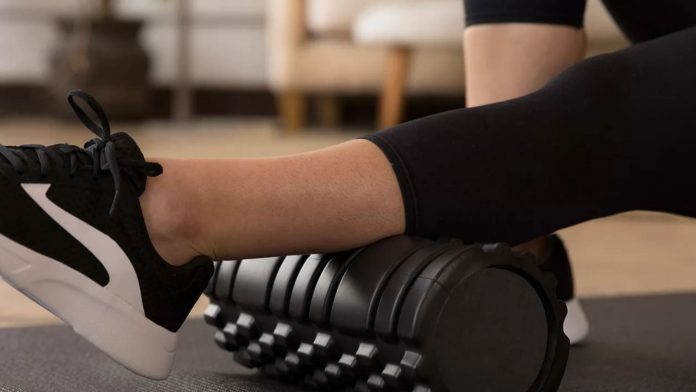Updated Aug 4, 2022 2:39 PM
If you’re searching for the best foam rollers on the market, chances are you’re already feeling the pain of working out, getting old, or just sitting in an office chair all day. Typically, a foam roller is not something you buy when everything is hunky-dory and you’re feeling like a million bucks. Instead, it tends to be a reactionary purchase to workout soreness, muscle or spinal ailments, or a degradation in your range of movement. Making sure you purchase the right roller is an important part of the recovery and sustainment process.
Navigating the long list of foam roller options could be a daunting task, especially if you’re unclear about what the differences could mean for you and your pesky injury. To help combat the confusion, we’ve put together a list of the top foam rollers in a variety of different categories to help you find the right roller to fit your needs and get you back into the workouts you love (or hate, but do anyway because you’re a badass).
Regular professional massages can get expensive, and if you’re an introvert like me, they’re kind of a nightmare anyway. But, good news, there is an alternative. The TriggerPoint GRID foam roller was designed to replicate the experience of visiting a professional massage therapist. The EVA foam surface has been shaped into a grid pattern (hence the name) and its varying surfaces and densities are meant to replicate the varying surfaces of a masseur’s hand. Wide flat sections replicate a flat palm, long, skinny sections represent fingers, and a series of individual nubs replicate fingertips. The wide range of options in this one foam roller is what makes it a favorite among physical therapists and personal trainers.
On a personal note, I bought this foam roller for myself and my wife and have been extremely impressed with its versatility and durability. At six-foot-two and 210 pounds, I’m by no means a small person, and I was initially worried about a product with a hollow core collapsing under my weight. After extensive use, I can happily report that I’ve found no signs of weakness in the product and I no longer have concerns about the product’s structural integrity. I use TriggerPoint GRID on a daily basis to work out the kinks in my lower back, hip flexors, and hamstrings.
Product Specs
-
Product dimensions:
Length: 13 inches / diameter: 5.5 inches -
Weight limit:
500 pounds -
Materials:
EVA (Ethylene Vinyl Acetate) foam around a hollow core
PROS
Employs multiple foam densities
Grid cut foam for customized experience
Durable hollow core
Variety of color options
Variety of size options
Affordable
CONS
May be a bit firm for people new to foam rolling
Sometimes it’s nice to just keep things simple, and the Amazon Basics High-Density Round Foam Roller does exactly that. Made from high-density polypropylene, the Amazon Basics foam roller is an affordable, no-frills option for anyone looking to build on their budget home gym or just simply roll out some sore muscles.
The Amazon Basics foam roller is literally just a cylinder of high-density foam, and when you get right down to it, that’s really all you need. The molded edges help maintain the roller’s structural integrity, making it unlikely that you’ll experience flaking or chipping at the edges.
I’ve used basic model high-density foam rollers like this before and they are extremely effective on muscles sore from lactic acid buildup. This plain roller is great if you’re new to foam rolling or if you’re experiencing a lot of muscle pain. If you’re in pain, the last thing you want is a roller that’s supposed to be ribbed for your pleasure, giving you a deep tissue massage where it’s not welcome. Sometimes, a smooth roller is just the smart choice.
The Amazon Basics foam roller is also useful for playfully swatting your children or spouse when they least expect it. Purchase two if you like to swordfight.
Product Specs
-
Product dimensions:
Length: 36 inches (also available in 12, 18, and 24 inches) / diameter: 6 inches -
Weight limit:
None -
Materials:
Polypropylene
PROS
Affordable
High-density to provide a stiff rolling surface
Molded edges to prevent chipping
Multiple color options
Lightweight
CONS
Limited functionality
May degrade structurally over time
I have lower back problems and, judging from a core sample of my friend group, I suspect a lot of people out there do, too. Unfortunately, a lot of us spend most of our working hours plunked into an office chair, building a nice case of carpal tunnel. But what most don’t realize—until it’s too late—is that with all the hours of sitting, we aren’t doing our backs any favors either. Fortunately, the good people at Chirp Wheel+ are here to help, and its series of foam rollers are specifically designed to help alleviate back pain, correct posture, and strengthen the muscles located directly along the spine.
Most foam rollers on the market today are long, semi-narrow cylinders, which can make it hard to target specific problem areas in the back and are often not tall enough to get good spinal curvature correction. At only five inches wide, the Chirp Wheel+ is designed specifically to run up and down your spine without getting hung up on your shoulder blades or spreading the pressure of your weight over too much surface area. The result is a targeted, high-pressure massage for the muscles right along your spine.
The Chirp Wheel+ comes in four different sizes, which can be purchased individually or in varying packs. These different sizes allow you to work on your flexibility in the thoracic and lumbar regions in your back and can even help you restore a proper, healthy spinal curvature.
Product Specs
-
Product dimensions:
Length: 5 inches / diameter: 12, 10, 6, 4 inches -
Weight limit:
500 pounds -
Materials:
EVA foam compression mat around a hollow ABS plastic core
PROS
Helps alleviate back pain
Helps correct spinal curvature and posture
Features “spinal channel” for maximum comfort
Non-slip texturing on foam mat
Comes in individual sizes or pack of multiple sizes
CONS
May not be as useful for other areas of the body
I’ve been a runner since I was 13 years old, and I can tell you that after especially long or especially hard runs, the last thing I want to do is roll my muscles over a rock-hard roller. That’s why I picked the 321 STRONG Foam Roller as the best roller for runners. With a medium-density EVA foam construction, you get a little cushion with your rolling experience and you won’t have to explain to your spouse why they can hear you weeping from the next room over.
Like the TriggerPoint GRID, the 321 STRONG foam roller is cut with a specific pattern to replicate the different pressure sensations of a massage therapist’s hands (i.e., wide flat areas replicate palms, long thin sections replicate fingers, and individual nubs for fingertips). This means that even with a little extra cushion, you can still get a quality deep tissue massage and target those problem areas causing you the most pain.
For anyone new to foam rolling, the 321 STRONG foam roller also comes with an e-book “Companion Guide” that can help walk you through effective uses and best practices.
Product Specs
-
Product dimensions:
Length: 12.75 inches / diameter: 5.25 inches -
Weight limit:
500 pounds -
Materials:
EVA foam, solid core
PROS
Medium density for beginners or extremely tender muscles
Grid cut foam for customized experience
Solid core
Variety of color options
CONS
May need to upgrade to a high-density roller later
Up your foam roller game with a vibrator! Wait, that came out wrong. The Lifepro Surger 4-Speed Vibrating Foam Roller is a great way of taking muscle recovery up a notch. Regular foam rollers are great, but a vibrating roller can help relieve tension and increase blood flow to targeted muscle groups and the surrounding tissue.
The Surger roller is made of low-density foam, providing a nice cushioned roll, and offers four levels of vibration intensity, so you can really customize your experience. The single-button toggle allows you to select between three different time durations (60/90/120 seconds), so you can keep precise track of how long you spend on each muscle group.
The Surger comes equipped with a rechargeable lithium battery that gives you up to four hours of power when fully charged. It also includes a convenient drawstring bag, so you can take the Surger anywhere, though I’m not sure I’d want to use a vibrating roller in a public space unless you’re cool with getting weird looks and possibly the police called on you.
Product Specs
-
Product dimensions:
Length: 13 inches / diameter: 5.5 inches -
Weight limit:
Not specified -
Materials:
Foam (sorry, that’s all they give)
PROS
Vibration helps relieve tension and increase blood flow
Four vibration setting
Three duration settings
CONS
Higher price
Foam might be to low-density for some users
If you’re someone who travels a lot, trying to keep a regular rolling routine can be very difficult because, after all, who wants to travel with a bulky foam roller taking up valuable real estate in their luggage? Fortunately, Brazyn has a solution with its Brazyn Morph Foam Roller. The Brazyn Morph is a fully collapsible foam roller that uses its patented Collapsible Core Technology to reduce the unit from a circular 5.5 inches down to a flat two inches. Weighing in at only 1.6 pounds, the Brazyn Morph can be easily stored in your backpack or other luggage, making it ideal for athletes on the go.
The Brazyn Morph is constructed using bamboo slats surrounding a collapsible core made primarily of recycled aluminum. The bamboo slats are then covered with medium-density foam for a layer of protection and comfort. The foam covering comes in two texture options, Alpha and Bravo, but both are designed to help stimulate muscle relaxation and recovery, as well as myofascial release.
While the Brazyn Morph may be a little more costly than the typical foam roller, you are getting a pretty unique product from a company doing its best to strive for quality and environmental sustainability.
Product Specs
-
Product dimensions:
Length: 14.5 inches / diameter: 5.5 inches -
Weight limit:
350 pounds -
Materials:
Bamboo / recycled aluminum / foam shell
PROS
Collapses to only two inches thick
Portable
Environmentally-conscious
Two surface texture options
CONS
Higher price than most basic foam rollers
Lower weight capacity
If you’re not the type of person who likes to get down on the ground and roll around, or maybe you’re so sore you’re worried you might not be able to get back up, the Tiger Tail Massage Stick might be the best option for you. Unlike traditional foam rollers, the Tiger Tail is a handheld roller, meaning that you apply all the pressure with your own strength, instead of using your body weight to apply pressure on the ground.
The Tiger Tail comes in three lengths (11, 18, and 22 inches), and is essentially a long dowel with thermoplastic handles on each end and a medical-grade foam covering in the center. To use the Tiger Tail, you simply grip both handles and apply firm pressure to sore muscles. The Tiger Tail’s main purpose is to help you work out tricky muscle knots that can often be the cause of prolonged stiffness and muscle pain.
With its small circumference, the Tiger Tail is another great option if you’re in the market for a portable foam roller, and is substantially cheaper than larger collapsible options, though it may be more work to get similar results.
Product Specs
-
Product dimensions:
Length: 18 inches / diameter: 1.62 inches -
Weight limit:
None -
Materials:
Plastic and medical-grade foam
PROS
Keeps you off the floor
Portable
Durable
Affordable
CONS
May be harder to reach areas of the back
No texturing for deeper tissue massage
Things to consider before buying a foam roller
Types of foam rollers
A key prerequisite of good foam rollers is their ability to — well — roll. This is why foam rollers tend to have the same long, cylindrical shape. Beyond this uniting feature, though, foam rollers can vary dramatically depending on their foam density, texture, core structure, or internal mechanics (as in the case of collapsible or vibrating rollers).
Two of the major features you’ll want to focus on when selecting a foam roller are the roller’s density and the texturing. With density, most foam rollers offer either medium- or high-density exteriors, with medium-density rollers being recommended for beginners or those dealing with severe pain, as they are more forgiving. The higher the density you go, the stiffer the massage will be.
The exterior pattern, or texture, of the roller is another major feature to consider. Basic foam rollers usually have flat, smooth surfaces, allowing you to spread the pressure of your weight over a larger surface area. Foam rollers with more intricate patterns or deep-cut grooves are intended for users who wish to get into deeper tissue and focus on more targeted areas of their muscles.
How to use foam rollers
In general, foam rollers are used as a way of easing muscle tension and soreness in areas of your body ranging from the bottoms of your feet to the back of your neck. You could probably even get in the downward dog position and massage the top of your scalp if you wanted to, though I’ve never seen it done. Foam rollers are typically used just before and/or just after a workout as a means of warming the body up and cooling down, respectively. The use of the foam roller post-workouts helps to increase blood flow and can prevent lactic acid in your muscles which would otherwise lead to soreness. Foam rollers are also used to work out existing muscle knots and promote increased flexibility and range of motion in your major muscle groups.
Foam rollers are simple and easy to use. With the foam roller on the ground, you simply place the desired muscle group above the roller and let your body weight create the pressure. With your arms and/or your legs, you slowly move back and forth allowing the roller to move over the desired area. This may be painful at first, especially for new users, but you can adjust the pressure simply by adjusting how much of your body weight you are holding up. By pivoting your body’s position on the roller, you can zero in on problem areas to work out specific muscle knots or get deeper into tissue. Most foam rollers come with instructional guides or offer free video guides online to demonstrate helpful techniques.
Benefits of foam rollers
Foam rollers offer a lot of health benefits for athletes and non-athletes alike. Not only does it feel good to get a massage, but by rolling out muscles, you can help to alleviate soreness/stiffness, increase blood flow, and increase muscle length (muscles tend to contract during post-workout recovery). All of these help to aid muscle recovery and help to improve future performance. Foam rollers have also been linked to improved posture, improved spinal flexibility, and corrected spinal curvature, not to mention relieving lower back pain caused by sciatica or inflammation of the soft tissues of the thoracic spine.
FAQs about foam rollers
Q: How much do foam rollers cost?
A: You can buy a good, basic foam roller for $15 to $20, but these are typically going to be solid core, polypropylene rollers with not much to offer in the way of surface texture. If you’re looking for a roller with some texture or a nice grid pattern, expect to pay between $30 and $45. Once you get above $45, you start to get into the foam rollers that offer extra features, such as vibration and collapsibility. These can range up over $100.
Q: Why does using foam rollers hurt?
A: When you start using a foam roller, you should expect it to hurt. In order to work out the tension of your muscles, you are applying pressure in order to elongate that tissue and/or work out existing knots that can form during workouts. Have no fear, though, because it’s supposed to hurt and the results are worth it. Prolonged pressure on muscle knots will cause them to release, and provide much-needed relief. Consistent use of your foam roller can help elongate muscles resulting in fewer injuries and less soreness.
Q: Can foam rolling be harmful?
A: Yes, but only in the way that anything can be harmful if not used correctly. Before using a foam roller, you should try to identify the cause of any pain or injury you might have. Once identified, be reasonably sure that a foam roller could be a potential solution. You won’t use a foam roller to treat a torn ACL or a herniated disk in your back. Be smart and consult a physician if you’re unsure.
Final thoughts
Working out is great, but it can lead to various pesky recurring aches and injuries. The older you get, the more important it is to take care of yourself pre- and post-workout or to just maintain a baseline of flexibility. The TriggerPoint GRID is a versatile, cheap, in-home way to alleviate the aches and pains of everyday life, so you can stay active and agile.
Methodology
I’ve been around the block a time or two when it comes to foam rollers. As a long-time long-distance runner, I’ve had my share of muscle/tendon ailments that have put me on the sidelines, and I’ve used foam rollers for a long time as a means of tempering those issues. Most recently, I’ve been dealing with a prolonged case of sciatica that has put me in and out of a physical therapy office for several months. While there, I used a wide variety of foam rollers and gained first-hand knowledge of the feel of different densities, grid patterns, and sizes. After completing my rounds of physical therapy, I bought the TriggerPoint GRID so that I could continue the therapy on my own at home. With all this first-hand experience, I feel confident in the recommendations I’ve made on this list.
Hands-on experience aside, I also spent hours researching different makes and models of foam rollers online. To do this, I consulted other similar product lists, online health journals, and even fitness videos on YouTube to see what the professionals were saying about the best foam rollers on the market. In order to narrow my list down to the select seven rollers featured above, I took special consideration into the rollers’ density levels, grid patterns (or lack thereof), durability, and how they fared in the reviews by those who’ve already put them to the test.
Task & Purpose and its partners may earn a commission if you purchase a product through one of our links. Learn more about our product review process.



